
The New World warblers or wood-warblers are a group of small, often colorful, passerine birds that make up the family Parulidae and are restricted to the New World. The family contains 120 species. They are not closely related to Old World warblers or Australian warblers. Most are arboreal, but some, like the ovenbird and the two waterthrushes, are primarily terrestrial. Most members of this family are insectivores.
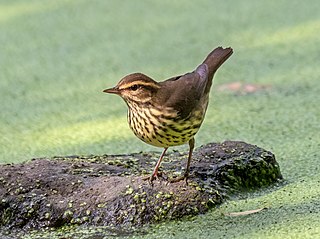
The northern waterthrush is a species of ground-feeding migratory New World warbler of the genus Parkesia. It breeds in the northern part of North America in Canada and the northern United States including Alaska, and winters in Central America, the West Indies and Florida, as well as in Venezuela, Colombia, and Ecuador. It is a rare vagrant to other South American countries and to western Europe. Its closest relative is the Louisiana waterthrush.
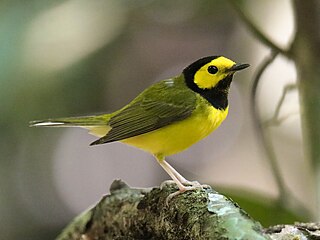
The hooded warbler is a New World warbler. It breeds in eastern North America across the eastern United States and into southernmost Canada (Ontario). It is migratory, wintering in Central America and the West Indies. Hooded warblers are very rare vagrants to western Europe.

The blue-winged warbler is a fairly common New World warbler, 11.5 cm (4.5 in) long and weighing 8.5 g (0.30 oz). It breeds in eastern North America in southern Ontario and the eastern United States. Its range is extending northwards, where it is replacing the very closely related golden-winged warbler.

The Nashville warbler is a small songbird in the New World warbler family, found in North and Central America. It breeds in parts of the northern and western United States and southern Canada, and migrates to winter in southern California and Texas, Mexico, and the north of Central America. It has a gray head and a green back, and its underparts are yellow and white.

The orange-crowned warbler is a small songbird of the New World warbler family.

The worm-eating warbler is a small New World warbler that breeds in the Eastern United States and migrates to southern Mexico, the Caribbean, and Central America for the winter.

The black-throated gray warbler or black-throated grey warbler is a passerine bird of the New World warbler family Parulidae. It is 13 cm (5.1 in) long and has gray and white plumage with black markings. The male has the bold black throat of its name, and black stripes on its head, as well as black streaks on its flanks; the female is a paler version of the male, with a white throat and less distinct black markings on the flanks and wings. It breeds in western North America from British Columbia to New Mexico, and winters in Mexico and the southwestern United States. The habitats it prefers are coniferous and mixed forests and scrubland, especially those with pinyon pines, junipers, sagebrush, and oaks. Its nest is an open cup of plant fibers lined with feathers, built a few metres from the ground in the branches of a tree or shrub. Three to five eggs are laid, and young are fed by both parents. Common in its breeding range, it does not seem to be seriously threatened by human activities, unlike many migratory warblers.

Townsend's warbler is a small songbird of the New World warbler family.

Parula was formerly a small genus of New World warblers which breed in North and South America.

The flame-throated warbler is a small New World warbler. It is sometimes placed in the genera Vermivora and Parula.

The elfin woods warbler is a species of bird endemic to Puerto Rico, where it is local and uncommon. Discovered in 1968 and described in 1972, it is the most recently described New World warbler.

Setophaga is a genus of birds of the New World warbler family Parulidae. It contains at least 34 species. The males in breeding plumage are often highly colorful. The Setophaga warblers are an example of adaptive radiation with the various species using different feeding techniques and often feeding in different parts of the same tree.

Adelaide's warbler is a bird endemic to the archipelago of Puerto Rico belonging to the genus Setophaga of the family Parulidae. The species is named after Maria Antoinette Adelaide Florentia del Carmen Swift Washburne (1829-1884), daughter of Robert Swift, the person who obtained the first specimen.

The red warbler is a small passerine bird of the New World warbler family Parulidae endemic to the highlands of Mexico, north of the Isthmus of Tehuantepec. It is closely related to, and forms a superspecies with, the pink-headed warbler of southern Mexico and Guatemala. There are three subspecies, found in disjunct populations, which differ in the color of their ear patch and in the brightness and tone of their body plumage. The adult is bright red, with a white or gray ear patch, depending on the subspecies; young birds are pinkish-brown, with a whitish ear patch and two pale wingbars.

The waterthrushes are a genus of New World warbler, Parkesia.
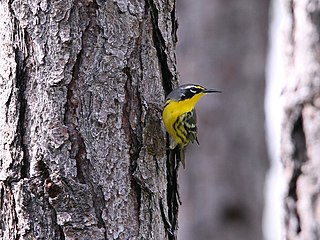
The Bahama warbler is an endangered species of bird in the family Parulidae that is endemic to The Bahamas.
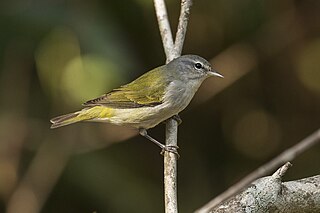
Leiothlypis is a genus of New World warbler, formerly classified within the genus Oreothlypis or Vermivora.
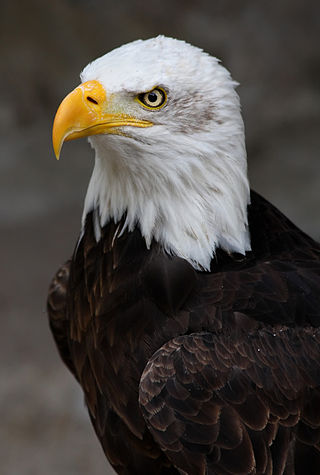
Accipitrimorphae is a clade of birds of prey that include the orders Cathartiformes and Accipitriformes. However, this group might be a junior synonym of Accipitriformes. The DNA-based proposal and the NACC and IOC classifications include the New World vultures in the Accipitriformes, but the SACC classifies the New World vultures as a separate order, the Cathartiformes which has been adopted here. The placement of the New World vultures has been unclear since the early 1990s. The reason for this is the controversial systematic history of the New World vultures as they were assumed to be more related to Ciconiidae after Sibley and Ahlquist work on their DNA-DNA hybridization studies conducted in the late 1970s and throughout the 1980s. The stork-vulture relationship has seemed to not be supported. Regardless of whether to use Accipitrimorphae or Accipitriformes, these birds belong to the clade Telluraves.
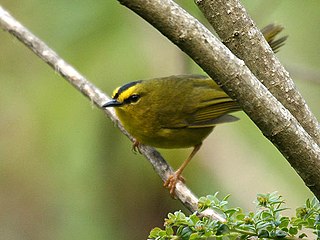
Myiothlypis is a genus of New World warblers, best represented in Central and South America. This is one of only two warbler genera that are well represented in the latter continent. All of these species were formerly placed in the genus Basileuterus.






















